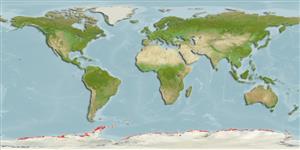Classification / Names
Common names from other countries
Main reference
Size / Weight / Age
Max length : 45.0 cm SL male/unsexed; (Ref. 11892)
Environment
Marine; benthopelagic; depth range 1 - 95 m (Ref. 11892), usually 1 - 90 m (Ref. 11892)
Climate / Range
Polar, preferred ?
Distribution
Southern Ocean: coast of the Antarctic continent, Antarctic Peninsula, South Georgia, South Shetland, South Orkney Islands and Peter I Island.
Countries | FAO areas | Ecosystems | Occurrences | Introductions
Short description
Dorsal
spines
(total): 3 - 7;
Dorsal
soft rays
(total): 37-40;
Anal
spines: 0;
Anal
soft rays: 27 - 32. Caudal fin subtruncate or slightly rounded, emarginate in young. Coloration more spectacular compared to other nototheniids. Juveniles with a black blotch on distal end of pectoral fin.
IUCN Red List Status (Ref. 115185)
Threat to humans
Harmless
Human uses
Fisheries: subsistence fisheries
More information
ReferencesAquacultureAquaculture profileStrainsGeneticsAllele frequenciesHeritabilityDiseasesProcessingMass conversion
Tools
Special reports
Download XML
Internet sources
Estimates of some properties based on models
Phylogenetic diversity index
PD50 = 0.5078 many relatives (e.g. carps) 0.5 - 2.0 few relatives (e.g. lungfishes)
Trophic Level
3.3 ±0.2 se; Based on diet studies.
Resilience
Low, minimum population doubling time 4.5 - 14 years (tm=7-8; Fec > 10,000)
Vulnerability
High to very high vulnerability (69 of 100)
Price category
